-
作者:Brumelle, S; Walczak, D
作者单位:University of British Columbia
摘要:When a customer requests a discount fare, the airline must decide whether to sell the seat at the requested discount or to hold the seat in hope that-a customer will, arrive later who will pay more. We model this situation for a single-leg flight with multiple fare classes and customers who arrive according to a semi-Markov process (possibly nonhomogeneous). These customers can request multiple seats (batch requests) and can be overbooked. Under certain conditions, we show that the value funct...
-
作者:Scheel, H; Scholtes, S
作者单位:Dortmund University of Technology; University of Cambridge
摘要:Data envelopment analysis (DEA) is a methodology that allows, in one way or other, the assignment of efficiency scores to members of a group of decision-making units. We call an efficiency measure continuous if small perturbations of the input-output data cause only small changes in the score. Continuity is a desirable property of an-efficiency measure, in particular in the presence of measurement tolerances. Continuity is also desirable from a,numerical point of view because the scores are co...
-
作者:Alp, O; Erkip, NK; Güllü, R
作者单位:University of Alberta; Middle East Technical University
摘要:We characterize optimal policies of a dynamic lot-sizing/vehicle-dispatching problem under dynamic deterministic demands and stochastic lead times. An essential feature of the problem is the structure of the ordering cost, where a fixed cost is incurred every time a batch is initiated (or a vehicle is hired) regardless of the portion of the batch (or vehicle) utilized. Moreover, for every unit of demand not satisfied on time, holding and backorder costs are incurred. Under mild assumptions we ...
-
作者:Ball, MO; Hoffman, R; Odoni, AR; Rifkin, R
作者单位:University System of Maryland; University of Maryland College Park; University System of Maryland; University of Maryland College Park; Massachusetts Institute of Technology (MIT); Massachusetts Institute of Technology (MIT)
摘要:In this paper, we analyze a generalization of a classic network-flow model. The generalization involves the replacement of deterministic demand with stochastic demand: While this generalization destroys the original network structure, we show that the matrix underlying the stochastic model is dual network. Thus. the integer program associated with the stochastic model can be solved efficiently using network-flow or linear-programming techniques We also develop an application of this model to t...

